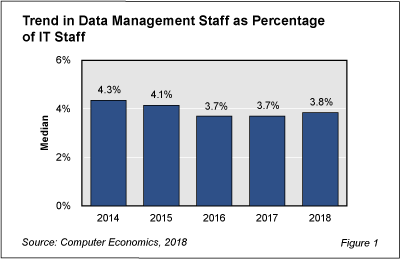The amount of data IT organizations have to manage is exploding. Users clamor for real-time access and mobile devices, and technology like the Internet of Things, ensure that there will be no slowdown in data volume. Yet data architects and data analytics personnel show no increase as a percentage of the typical IT staff.
As shown in Figure 1 from our full report, Data Management Staffing Ratios, during the past three years this category of IT workers has remained basically flat as a percentage of the IT staff. They now account for 3.8% of the typical IT staff at the median, which is similar to 3.7% in 2016 but down from its recent peak of 4.3% in 2014.

Several factors are contributing to the leveling off of the data management headcount. For instance, analytical tools embedded within application systems, such as ERP, CRM, and HCM, and more powerful self-service reporting tools directly in the hands of users, are reducing the reliance on data management staff within the IT organization for routine reporting. (When considering all these influences, it is important to note that assessing requirements for data management staffing varies considerably from industry to industry and from organization to organization.)
“It is possible that data management staffing is poised for another round of growth,” said David Wagner, vice president of research for Computer Economics of Irvine, Calif. “The growth in AI and IoT requires having your data ducks in a row, and once implemented both technologies produce a lot of new data. Improved processes and automation may not make up for the explosive growth we are expecting. At any rate, the changes in this area make it important to watch this space in the coming years to maintain proper staffing levels.”
Businesses are investing in data management today primarily to provide business leaders with richer information to make better decisions. IT executives need to align their departments with these business objectives, but they also need to ensure that decision-makers understand the full costs of supporting analytical and reporting systems, particularly as they take the technology to the next level of delivering real-time operational data.
We define the data management staff as those individuals who design, develop, architect, and model data schemas and databases for the organization. They also may design the organization’s data warehouse and business intelligence systems and analyze information maintained by such systems. This category does not include database administrators, who reside in the database administration category.
There is a limit to how much the data demands can be satisfied without staff increases. In such a fluid environment, IT managers need to assess appropriate staffing levels on an ongoing basis using current data. In our full report, we use four benchmarks to assess data management staffing levels: data management staff as a percentage of the IT staff, data management staff as a percentage of the Application Group, users per data management staff member, and applications per data management staff member.
This Research Byte is a brief overview of our report on this subject, Data Management Staffing Ratios. The full report is available at no charge for Computer Economics clients, or it may be purchased by non-clients directly from our website (click for pricing).
Do you also need staffing ratios for other IT job functions? Consider this collection of all of our staffing ratio reports, which bundles them all into a single report at a significant discount: IT Staffing Ratios–Special Report Bundle.

